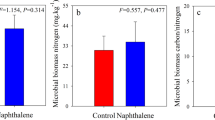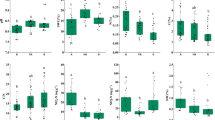Abstract
Exotic plant species can benefit from altering soil microbial communities; however, the knowledge of the mechanisms through which this occurs is limited. The exotic species, Eupatorium adenophorum is a perennial plant that is aggressively invading southern China. Its invasiveness is attributed partially to its ability to release secondary chemicals that affect native plant species. Nevertheless, their effect on soil bacterial communities has rarely been explored. Here, we used natural fresh leaf and root leachate of E. adenophorum, and two pure, phytotoxic chemicals amorpha-4,7(11)-dien-8-one, and 6-hydroxy-5-isopropyl-3,8-dimethyl-4a,5,6,7,8,8a-hexahydraphthalen-2(1H)-one to evaluate: (a) short-term (3 days) effects of secondary chemicals on soil bacterial communities in mixed forests and (b) long-term (6 months) effects of leaf leachate on soil bacterial communities in three habitats. Additionally, the composition and diversity of soil bacterial communities were explored with high throughput sequencing using IlluminaMiSeq. In the short-term experiments, all treatments affected soil bacterial communities, but leaf leachate most significantly reduced soil bacterial richness and diversity. In the long-term experiments, leaf leachate altered bacterial communities in all soil samples, and reduced bacterial richness and diversity in soils from the forest and wasteland, but increased bacterial richness and diversity in soils from roadside. Redundancy analysis indicated that changes in bacterial communities were associated with soil organic carbon, nitrogen content, and pH. These results indicate that the water-dissoluble secondary chemicals of E. adenophorum, especially from its leaves, have an impact on soil bacterial communities, though the degree of the impact depends on soil ecotype.






Similar content being viewed by others
References
Callaway RM, Aschehoug ET (2000) Invasive plants versus their new and old neighbors: a mechanism for exotic invasion. Science 290:521–523
Callaway RM, Thelen GC, Rodriguez A, Holben WE (2004) Soil biota and exotic plant invasion. Nature 427:731–733
Chapman SK, Langley JA, Hart SC, Koch GW (2006) Plants actively control nitrogen cycling: uncorking the microbial bottleneck. New Phytol 169:27–34
Dai L, Li HN, Jiang ZL, Wan FH, Liu WX (2012) Invasive effects of Ageratina adenophora (Asteraceae) on the changes of effective functional bacteria, enzyme activity and fertility in rhizosphere soil ecosystem. Ecol Environ 21:237–242
Drenovsky RE, Vo D, Graham KJ, Scow KM (2004) Soil water content and organic carbon availability are major determinants of soil microbial community composition. Microb Ecol 48:424–430
Eilers KG, LauberCL Knight R, Fierer N (2010) Shifts in bacterial community structure associated with inputs of low molecular weight carbon compounds to soil. Soil Biol Biochem 42:896–903
Fierer N, Jackson RB (2006) The diversity and biogeography of soil bacterial communities. Proc Natl Acad Sci USA 103:626–631
Fujii K, Satomi M, Morita N, Motomura T, Tanaka T, Kikuchi S (2003) Novosphingobium tardaugens sp nov., an oestradiol-degrading bacterium isolated from activated sludge of a sewage treatment plant in Tokyo. Int J Syst Evol Microbiol 53:47–52
Funk JL, Vitousek PM (2007) Resource-use efficiency and plant invasion in low-resource systems. Nature 446:1079–1081
Gui FR, Jiang ZL, Jin JB, He SQ, Jiang XC (2011) Allelopathic effect of Ageratina adenophora on seed germination of nine herbaceous species. J Biosaf 20:331–336
Haichar FE, Marol C, Berge O, Rangel-Castro J, Prosser JI, Balesdent J, Heulin T, Achouak W (2008) Plant host habitat and root exudates shape soil bacterial community structure. ISME J 2:1221–1230
Hierro JL, Callaway RM (2003) Allelopathy and exotic plant invasion. Plant Soil 256:29–39
Hooper DU, Bignell DE, Brown VK, Brussard L, Dangerfield JM, Wall DH, Wardle DA, Coleman DC, Giller KE, Lavelle P, Van der Putten WH, de Ruiter PC, Rusek J, Silver WL, Tiedje JM, Wolters V (2000) Interactions between aboveground and belowground biodiversity in terrestrial ecosystems: patterns, mechanisms, and feedbacks. BioScience 50:1049–1061
Inderjit EH, Crocoll C, Bajpai D, Kaur R, Feng YL, Silva C, Carreon JT, Valiente-Banuet A, Gershenzon J, Callaway RM (2011) Volatile chemicals from leaf litter are associated with invasiveness of a Neotropical weed in Asia. Ecology 92:316–324
Jia HJ, Li XK, Tang SC, Tang SQ, Lu SH, Xu XL (2009) Allelopathic effects of Eupatorium adenophorum on seed germination of three woody plants in karst region. Guihaia 29:631–634
Lauber CL, HamadyM Knight R, Fierer N (2009) Pyrosequencing-based assessment of soil pH as a predictor of soil bacterial community structure at the continental scale. Appl Environ Microbiol 75:5111–5120
Liao F, Hu YC, Tian H, Wu L, Wang YF, Huang Y, Mo Q, Wei YH (2014) Acaricidal activity of 9-oxo-10,11-dehydroageraphorone extracted from Eupatorium adenophorum in vitro. Exp Parasitol 140:8–11
Lorenzo P, Pereira CS, Rodriguez-Echeverria S (2013) Differential impact on soil microbes of allelopathic compounds released by the invasive Acacia dealbata Link. Soil Biol Biochem 57:156–163
Maron JL, KlironomosJ Waller L, Callaway RM (2014) Invasive plants escape from suppressive soil biota at regional scales. J Ecol 102:19–27
Meisner A, Hol WHG, de Boer W, Krumins JA, Wardle DA, Van der Putten WH (2014) Plant-soil feedbacks of exotic plant species across life forms: a meta-analysis. Biol Invasions 16:2551–2561
Muniappan R, Raman A, Reddy GVP (2009) Ageratina adenophora (Sprengel) King and Robinson (Asteraceae). In: Biological control of tropical weeds using arthropods. Cambridge University Press, Cambridge, pp 63–73
Niu HB, Liu WX, Wan FH, Liu B (2007) An invasive aster (Ageratina adenophora) invades and dominates forest understories in China: altered soil microbial communities facilitate the invader and inhibit natives. Plant Soil 294:73–85
Piper CL, Siciliano SD, Winsley T, Lamb EG (2015) Smooth brome invasion increases rare soil bacterial species prevalence, bacterial species richness and evenness. J Ecol 103:386–396
Portales-Reyes C, Van Doornik T, Schultheis EH, Suwa T (2015) A novel impact of a novel weapon: allelochemicals in Alliaria petiolata disrupt the legume-rhizobia mutualism. Biol Invasions 17:2779–2791
Ramirez KS, Lauber CL, Knight R, Bradford MA, Fierer N (2010) Consistent effects of nitrogen fertilization on soil bacterial communities in contrasting systems. Ecology 91:3463–3470
Shrestha K, Wilson E, Gay H (2009) Ecological and environmental study of Eupatorium adenophorum Sprengel (banmara) with reference to its gall formation in Gorkha-langtang route, Nepal. Nat Hist Mus 23:108–124
Sohn JH, Kwon KK, Kang JH, Jung HB, Kim SJ (2004) Novosphingobium pentaromativorans sp nov., a high-molecular-mass polycyclic aromatic hydrocarbon-degrading bacterium isolated from estuarine sediment. Int J Syst Evol Microbiol 54:1483–1487
Strickland MS, Osburn E, Lauber C, Fierer N, Bradford MA (2009) Litter quality is in the eye of the beholder: initial decomposition rates as a function of inoculum characteristics. Funct Ecol 23:627–636
Suding KN, Harpole WS, Fukami T, Kulmatiski A, MacDougall AS, Stein C, Van der Putten WH (2013) Consequences of plant-soil feedbacks in invasion. J Ecol 101:298–308
Sun X, Gao C, Guo LD (2013a) Changes in arbuscular mycorrhizal fungus community along an exotic plant Eupatorium adenophorum invasion in a Chinese secondary forest. Microbiology 51:295–300
Sun X, Gao C, Guo LD (2013b) Changes in soil microbial community and enzyme activity along an exotic plant Eupatorium adenophorum invasion in a Chinese secondary forest. Chin Sci Bull 58:4101–4108
Tripathi BM, Kim M, Singh D, Lee-Cruz L, Lai-Hoe A, Ainuddin AN, Adam JM (2012) Tropical soil bacterial communities in Malaysia: pH dominates in the equatorial tropics too. Microb Ecol 64:474–484
van der Heijen MGA, Bardgett RD, Van Straalen NM (2008) The unseen majority: Soil microbes as drivers of plant diversity and productivity in terrestrial ecosystems. Ecol Lett 11:296–310
Vivanco JM, Bais HP, Stermitz FR, Thelen GC, Gallaway RM (2004) Biogeographical variation in community response to root allelochemistry: novel weapons and exotic invasion. Ecol Lett 7:285–292
Wang Q, Garrity GM, Tiedje JM, Cole JR (2007) Naive Bayesian classifier for rapid assignment of rRNA sequences into the new bacterial taxonomy. Appl Environ Microbiol 73:5261–5267
Wolfe BE, Klironomos JN (2005) Breaking new ground: soil communities and exotic plant invasion. Bioscience 55:477–487
Xu CW, Yang MZ, Chen YJ, Chen LM, Zhang DZ, Mei L, Shi YT, Zhang HB (2012) Changes in non-symbiotic nitrogen-fixing bacteria inhabiting rhizosphere soils of an invasive plant Ageratina adenophora. Appl Soil Ecol 54:32–38
Yang GQ (2006) Main allelochemicals isolated and identified from the leachates of Ageratina adenophora Sprengel (Asteraceae) and their action mechanisms on upland rice (Oryza sativa) seedlings. Dissertation, Chinese Academy of Agricultural Sciences
Yang GQ, Wan FH, Liu WX, Guo JY (2008) Influence of two allelochemicals from Ageratina adenophora Sprengel on ABA, IAA and ZR contents in roots of upland rice seedlings. Allelopathy J 21:253
Yang GQ, Qiu WR, Jin YN, Wan FH (2013) Potential allelochemicals from root exudates of invasive Ageratina adenophora. Allelopathy J 32:233
Zhang FJ, Guo JY, Chen FX, Liu WX, Wan FH (2012) Identification of volatile compounds released by leaves of the invasive plant croftonweed (Ageratina adenophora, Compositae), and their inhibition of rice seedling growth. Weed Sci 60:205–211
Zheng L, Feng YL (2005) Allelopathic effects of Eupatorium adenophorum Sprengel on seed germination and seedling growth in ten herbaceous species. Acta Ecol Sin 25:2782–2787
Zhu XZ, Zhang JT, Ma KP (2011) Soil biota reduce allelopathic effects of the invasive Eupatorium adenophorum. PLoS ONE 6:e25393
Acknowledgements
We are grateful to the Public Technical Service Center of Xishuangbanna Tropical Botanical Garden, Chinese Academy of Sciences for analyzing soil chemical properties. This research was financially supported by the National Natural Science Foundation of China (NSFC) (Nos. 31300466 and 31100410), the Natural Science Foundation of Jiangsu Province (BK20130461), Jiangsu Overseas Research &Training Program for University Prominent Young & Middle-aged Teachers and Presidents, the West Light Foundation of Chinese Academy of Sciences, and the Chinese Academy of Sciences 135 program (XTBG-T01, F01).
Author information
Authors and Affiliations
Corresponding authors
Additional information
Xunzhi Zhu and Yangping Li have contributed equally to this work.
Electronic supplementary material
Below is the link to the electronic supplementary material.
Fig. S1
Average relative abundance of bacterial phylum in soils with pre-treatment (BT), the addition of DTD, HHO, leaf leachate (LL), root leachate (RL),and control (CK) treatments. Bars represent means ± SE, n=3. (DOCX 119 kb)
Fig. S2
Average relative abundance of bacterial phylum in before and after the addition of water (control) and the addition of leaf leachate of E. adenophorum in in soils from forest, roadside and wasteland habitats. Letters “F,” “R,” and “W” indicate soils from forest, roadside and wasteland habitats. Letters “B,” “AC,” and “T” indicate before treatment, control, and the addition of leaf leachate of E. adenophorum treatments. (DOCX 226 kb)
Rights and permissions
About this article
Cite this article
Zhu, X., Li, Y., Feng, Y. et al. Response of soil bacterial communities to secondary compounds released from Eupatorium adenophorum. Biol Invasions 19, 1471–1481 (2017). https://doi.org/10.1007/s10530-017-1371-y
Received:
Accepted:
Published:
Issue Date:
DOI: https://doi.org/10.1007/s10530-017-1371-y




